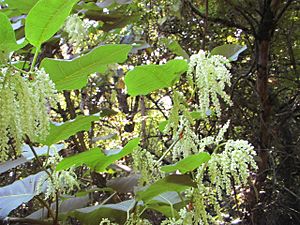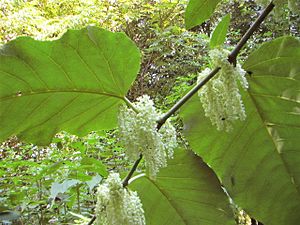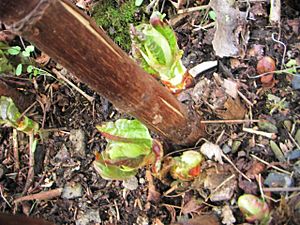Giant knotweed facts for kids
Quick facts for kids Giant knotweed |
|
|---|---|
 |
|
| Scientific classification | |
| Synonyms | |
|
Reynoutria sachalinensis, also known as giant knotweed or Sakhalin knotweed, is a type of plant. It is native to parts of Asia, including northern Japan and the far east of Russia. In Japanese, it's called ooitadori, and in Russian, it's known as Gorets sakhalinskiy.
This plant is a herbaceous perennial. This means it has soft stems, not woody ones, and it lives for more than two years. Giant knotweed can grow very tall, usually between 2 and 4 meters (about 6.5 to 13 feet). It has strong underground stems called rhizomes that spread widely. These rhizomes help the plant form large groups of identical plants, like a big family.
The leaves of the giant knotweed are quite large. They can be up to 15 to 40 cm (about 6 to 16 inches) long and 10 to 28 cm (about 4 to 11 inches) wide. They are shaped like a heart at the bottom and have a slightly wavy edge.
Flowers and Reproduction
The plant produces small flowers in late summer or early autumn. These flowers grow in dense clusters up to 10 cm (about 4 inches) long. Interestingly, giant knotweed has separate male and female flowers on different plants. This is a special way it reproduces.
Giant knotweed is closely related to Japanese knotweed (Reynoutria japonica). You can tell them apart because giant knotweed is usually bigger. Also, its leaves have a heart-shaped base, while Japanese knotweed has a straight leaf base.
Uses and Spread
The young shoots of the giant knotweed are soft and can be eaten. This plant was brought to Europe a long time ago and planted in many botanical gardens. Around 1893, it became very popular. There was a time when cattle didn't have enough food due to a dry spell. Giant knotweed was not affected much by the drought. Its soft shoots and leaves were eaten by farm animals. Because of this, people started growing it widely to feed their livestock.
However, it turned out to be less useful than people thought. So, growing it on purpose has mostly stopped. But, like Japanese knotweed, it has become an invasive weed in some areas. This means it can spread very quickly and take over places where other plants used to grow.
Giant knotweed has also mixed with Japanese knotweed. This created a new plant called Reynoutria × bohemica. This hybrid plant is often found in places like the British Isles.
Scientists have found that extracts from this plant can be used to protect other plants. They can help fight against certain diseases caused by fungi and bacteria. Giant knotweed has also been grown to produce biomass, which is plant material used for energy. It can grow very well even in colder places, producing a lot of plant material each year.
See also
 In Spanish: Fallopia sachalinensis para niños
In Spanish: Fallopia sachalinensis para niños



